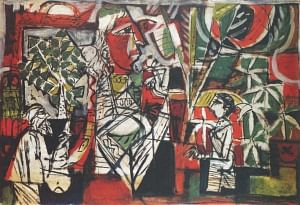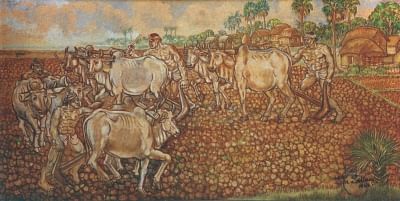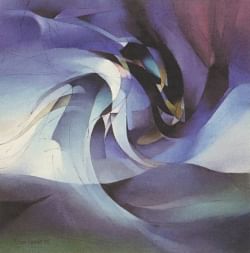| Home - Back Issues - The Team - Contact Us |
 |
| Volume 11 |Issue 50| December 21, 2012 | |
|
|
Art Creations that Touch Our Roots FAYZA HAQ "Rooted Creativity-11”, (that ended early this month) is an anniversary exhibition to commemorate the works of the pioneers of Bangladeshi art. For artists like Shilpacharya Zainul Abedin it was a big step leaving the comfort of Kolkata. After training under maestros of painting and sculpture, they took the brave path to Dhaka. They set up the Fine Arts Institute, DU, with teachers in Bangladesh like Mohammed Kibria and Shafiuddin Ahmed. Qamrul Hassan joined to form the unsurpassable trio to be helped by SM Sultan, in his trailing cloak and ringlets. There was Anwarul Huq too who travelled to Europe and West Pakistan. The powerful sketches in black and white by Zainul Abedin moved the whole world and not just the Indian Subcontinent. What these artists, took with them leaving the security of Kolkata, was hope in the future in the land of jute and hilsa. They deified Nature around them and blended the beauty of what their eye perceived around them. Many of them, while depicting nature, included the female form.
The skills of folk art and craft greatly influenced Qamrul Hasan in his drawings in presenting the sari-clad women – collecting water from the nearby pond and modestly covering their faces with their anchaal. In fact he is often spoken about as “Potua” Qamarul, the word denoting folk artist. However, Qamrul was not just limited to folk art, as we know it, with its origin in the Bengal School. He stressed on the rural roots of the people of Bengal, with their simple ways, and their trust in God, to deliver them from any evil or mishap that surrounded them. After the Partition of India, Anwarul Huq left Kolkata to join Zainul Abedin in 1948, He was not fascinated by the nouveau trends and did paintings which were indeed nonpareil and eye-catching for their haunting and realistic effect.
SM Sultan studied art formally only till 1940. His own style took over, exaggerating the muscular bodies and limbs of men and even angels. In the 90s and 80s Sultan's work became popular and well-known. It was aging rural life of Bengal which inspired him to paint. He kept up the culture of people around him, if anyone did. His obsession with exaggeration was to stress on the rich cultural backdrop of the places and people which he wanted to delineate and glorify. The ambitious and powerful painters went hand in hand in carefully and lovingly moulding the minds of the young, hopeful painters and sculptures, who came to the Dhaka College of Arts. Many of them went to Europe and the US to learn from the western world, and not just Kolkata. It is these artists who have been pathfinders for others who followed their footsteps in painting, sculpture and tapestry. Their skill, knowledge and dedication were handed over to the younger artists, whom they guided. Hence Bangladesh became a place of burgeoning gallery centres, where painters were supported and encouraged. In present times, the style theme, and sense of values of the artists are influenced, and are taught to be different. Even the work of the student painters is very much in demand. As for print making and commercial art, that too has been encouraged, such as lithography and the art of monotint.
Zainul Abedin's “Santal Couple “and “Cart” as well as the sketch from Mexico are well-known and loved. The lines and colours of Nature and man are simple and moving. Anwarul Haque's “Angling” and portrait of oil on canvas of 1956 are realistic, moving and inspiring. The boat, ripples of water, the angling man, his clothes and umbrella make a visual pattern that can't be forgotten Qamrul Hassan's “Bangladesh” and “Four Women are geometrical shaped, and flamboyant with colours. These vary from red, blued, brown, black, brown and blue are used these are to represent women, nature. The colours and lines are dramatic, to say the least. His “Two Women” and “Cattle In moonlight” poster colours and are marvellous for their minimum use of colours and simple but moving and dramatic lines. SM Sultan's “Going uphill” of 1970 and “Ploughing”are in blues and browns, and done in details – as regards stones, barks, clouds, human pullers and farmers in “dhoti”, bulls and light, daintily don trees in the background. Gray, reddish-brown, and pearly white are the colours used. “Oneness” pulsating with burnish earthy hues of red, brown black and white. This is Hamidur Rahman's offering in burnished colours. Abdur Razzaque's “A Standing Figure" an etching of 1957 and his “Landscape” a watercolour, full of buoyant yellows, greens. and brown remain interesting and unique. As usual 'Rooted Creativity' is a reminder to the people of Bangladesh, the sheer genius of each of these maestroes in depicting their motherland creating styles that will always remain unique and unforgettable.
Copyright
(R) thedailystar.net 2012 |
||||||||||||||||



